Listed buildings in Stoke-on-Trent
Stoke-on-Trent is a city in Staffordshire, England. Known as The Potteries and is the home of the pottery industry in the United Kingdom. Formed in 1910 from six towns, the city has almost 200 listed buildings within the city. Many of these are connected with the pottery industry and the people involved with it.
The term "listed building", in the United Kingdom, refers to a building or structure designated as being of special architectural, historical, or cultural significance under the Planning (Listed Buildings and Conservation Areas) Act 1990. They are categorised in three grades: Grade I consists of buildings of outstanding architectural or historical interest, Grade II* includes significant buildings of more than local interest and Grade II consists of buildings of special architectural or historical interest. Buildings in England are listed by the Secretary of State for Culture, Media and Sport on recommendations provided by English Heritage, which also determines the grading.[1]
Key
| Grade | Criteria[1] |
|---|---|
| I | Buildings of exceptional interest, sometimes considered to be internationally important |
| II* | Particularly important buildings of more than special interest. |
| II | Buildings of national importance and special interest. |
Listed buildings and structures
| Name and location | Photograph | Grade | Date | Notes |
|---|---|---|---|---|
| Mausoleum for the Marquis of Stafford grid reference SJ 8680 4106 52°58′0″N 2°11′53″W |
 |
I | c.1808 | The mausoleum for the Marquis of Stafford was designed by Charles Heathcote Tatham. Built of ashlar in a neo-Egyptian style it is the only Grade I listed building in the city.[2] |
| Farmhouse, Garden Street, Penkhull grid reference SJ 8682 4478 53°0′1″N 2°11′52″W |
II | c.1780 | Late 18th century T-plan farmhouse with 19th century additions and modifications. Probably built around 1780 when Josiah Spode II leased the farm.[3] | |
| The Vine Public House, Naylor Street, Pitshill grid reference SJ 8674 5227 53°4′3″N 2°11′57″W |
II | c.1875 | Rare surviving example of 19th century back street public house that retains original layout and fittings.[4] | |
| Hanley St Lukes Church of England Primary School grid reference SJ 8883 4753 53°1′30″N 2°10′5″W |
II | 1893 | Late Victorian school building in Vernacular Revival style. Incorporates a large number of contemporary tiles from the nearby Mintons pottery.[5] | |
| Chest tombs of Whalley and Broade family, Stoke Minster grid reference SJ 8790 4519 53°0′14″N 2°10′54″W |
II | 1796–1844 | Located in the churchyard of St. Peter ad Vincula, Stoke a pair of Chest tombs from late 18th and mid 19th centuries commemorates members of the Whalley and Broade families.[6] | |
| Fragment of Anglo-Saxon Cross, Stoke Minster grid reference SJ 8788 4516 53°0′13″N 2°10′55″W |
II | c.900 | Located in the churchyard of St. Peter ad Vincula, Stoke, a fragment of an early 10th century Anglo-Saxon cross that was re-erected in the mid 19th century on a tooled base surrounded by railings by local architect and amateur archaeologist Charles Lynam.[7] | |
| Remains of earlier church in St Peter's churchyard grid reference SJ 8792 4513 53°0′12″N 2°10′53″W |
.jpg.webp) |
II | 13th century | 13th century arch from a previous church building on the site of St. Peter ad Vincula, Stoke. The stones were reassembled by local architect and amateur archaeologist Charles Lynam in the 1880s.[8] |
| North Staffordshire School for the Deaf, Hartshill grid reference SJ 8688 4526 53°0′16″N 2°11′49″W |
II | 1803 | Early 19th century ashlar and brick house built for the potter Josiah Spode. Now the North Staffordshire School for the Deaf.[9] | |
| Elm House, Handley Street, Tunstall grid reference SJ 8677 5446 53°5′14″N 2°11′56″W |
II | c.1780 | Late 17th Century farmhouse, now a house. Extended in mid 18th century[10] | |
| Pottery works formerly occupied by Dudson's Ltd, Hannover Street, Hanley grid reference SJ 8805 4800 53°1′45″N 2°10′47″W |
 |
II | c.1820 | Pottery works comprising a number of buildings surrounding a central courtyard and kiln. Originally built in the 1820s substantial modifications were made in 1872.[11] |
| 283 Hartshill Road, Hartshill grid reference SJ 8663 4578 53°1′45″N 2°10′47″W |
II | c.1840 | Early 19th century one and a half storied cottage in the Gothic Revival style.[12] | |
| Holy Trinity Church, Hartshill grid reference SJ 8654 4583 53°0′35″N 2°12′7″W |
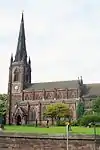 |
II* | 1842 | Designed by George Gilbert Scott and William Bonython Moffatt, Holy Trinity is the parish church and was constructed in 1842 in the Gothic Revival style. The church was endowed by Herbert Minton, son of the founder of Thomas Minton & Sons.[13] |
| Ford Hayes farmhouse grid reference SJ 9247 4616 53°0′46″N 2°6′49″W |
II | c.1780 | A farmhouse dating from the late 18th century. It was the birthplace and childhood home of Hugh Bourne, the founder of Primitive Methodism.[14] | |
| Christ Church, Tunstall grid reference SJ 8595 5171 53°3′45″N 2°12′40″W |
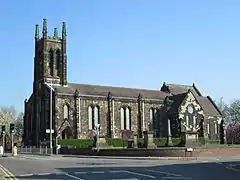 |
II | 1831–1832 | A Commissioners' church built in the early 1830s. It was designed by Francis Bedford and is of stone construction with a slate roof.[15] |
| Boundary Works, King Street, Longton grid reference SJ 9078 4376 52°59′28″N 2°8′19″W |
 |
II | 1819 | Early 19th century pottery works formerly occupied by Leo Samuels Ltd. Of brick construction with a tiled roof[16] |
| Bottle ovens and chimney at Albion Works, King Street, Longton grid reference SJ 9081 4369 52°59′26″N 2°8′18″W |
II | c.1900 | Two brick built Bottle ovens with attendant chimney stack[17] | |
| Sutherland Institute & Library, Lightwood Road, Longton grid reference SJ 9118 4293 52°59′1″N 2°7′58″W |
 |
II | 1898 | Designed by local architects Wood & Hutchings and built of brick picked out with terracotta, the three storey building was constructed on land donated by the 4th Duke of Sutherland and named in his honour. A decorative Bass-relief Frieze in terracotta depicting the pottery, mining and metal working industries was added in 1908.[18] |
| Former School of Art, London Road, Stoke grid reference SJ 8755 4501 53°0′8″N 2°11′13″W |
II | c.1853 | Mid 19th century art school designed by Edward Pugin and his partner James Murray. Built of brick interspersed with stone bands and dressings and with a slate roof. Now used as offices.[19] | |
| 45, 47 & 49 Longton Road, Trentham grid reference SJ 8718 4089 52°57′55″N 2°11′32″W |
II | 1875 | Terrace of 3 cottages in the Arts and Crafts style built for the Sutherland estate. Brick with timber framing and plain tiled roof.[20] | |
| 51 & 53 Longton Road, Trentham grid reference SJ 8717 4093 52°57′56″N 2°11′33″W |
II | c.1870 | A pair of timber framed cottages with brick infill in a herringbone pattern. Built on the plinth of an earlier 18th century structure and incorporating some brickwork from the earlier period in a bay on the left hand side.[21] | |
| Church of St Thomas the Apostle, Penkhull grid reference SJ 8691 4480 53°0′1″N 2°11′47″W |
.jpg.webp) |
II | 1842 | Designed by George Gilbert Scott, the parish church of Penkhull is a spired building of squared sandstone. In the late 19th century aisles were added.[22] |
| 36 Market Place, Burslem grid reference SJ 8675 4981 53°2′44″N 2°11′56″W |
II | c.1780 | Late 18th century 3 storeyed shop of Stuccoed brick.[23] | |
| Old Town Hall, Burslem grid reference SJ 8683 4984 53°2′45″N 2°11′52″W |
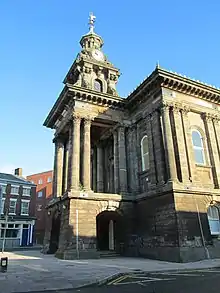 |
II* | 1854 | The second Town Hall built in Burslem, this two storeyed ashlar building was designed in the Baroque Revival style by G. T. Robinson. Since it ceased to be the Town Hall, it has been used variously as a library, recreation centre, a pottery museum (Ceramica) and most recently a sixth form college.[24] |
| Former school house at Stoke Union Workhouse, Newcastle Road, Hartshill grid reference SJ 8564 4526 53°0′16″N 2°12′55″W |
II | 1842 | Now situated within the grounds of the City General Hospital, the 2 storeyed, 15 bay workhouse schoolhouse is of Flemish Bond brickwork picked out with Staffordshire blue brick headers.[25] | |
| Warehouse in Price and Kensington Works, Newcastle Street, Longport grid reference SJ 8575 4967 53°2′39″N 2°12′50″W |
II | c.1820 | Early 19th century warehouse inside the pottery works of Price and Kensington. Of brick construction with hipped tile roof.[26] | |
| Sutherland Works, Normacot Road, Longton grid reference SJ 9134 4304 52°59′5″N 2°7′49″W |
II | c.1850 | 19th century pottery works, including 2 bottle ovens. Main building is 2 storeyed with 13 bays of brick with Staffordshire blue brick dressings. The overns are circular and are contained with the rear ranges of the works.[27] | |
| Etruria Hall, Etruria grid reference SJ 8700 4766 53°1′34″N 2°11′43″W |
 |
II | c.1770 | Designed for Josiah Wedgwood by Joseph Pickford, Etruria Hall is a 3 storeyed, 5 bayed hall brick structure with a 2 storeyed wing on each side. Extensively rebuilt in the 19th century the hall later became offices for Shelton Iron & Steel Company and now forms part of a hotel on the site of the 1986 National garden Festival.[28] |
| Etruscan Bone Mill, Etruria grid reference SJ 8721 4682 53°1′7″N 2°11′31″W |
II* | 1857 | Mid 19th century bone mill built of brick with a slate roof. Now forms part of the Etruria Industrial Museum.[29] | |
| War Memorial, Albert Square, Fenton grid reference SJ 8907 4455 52°59′53″N 2°9′51″W |
.jpg.webp) |
II | c.1919 | Ashlar cenotaph erected to commemorate the fallen of the First World War. On one side of the monument is a bas-relief figure of a soldier with reversed arms.[30] |
| War Memorial, Albion Square, Hanley grid reference SJ 8831 4741 53°1′26″N 2°10′32″W |
II | c. 1920 | Ashlar pedestal surmounted by larger than life sized bronze statue of Victory.[31] | |
| Bethesda Methodist Chapel, Hanley grid reference SJ 8822 4735 53°1′24″N 2°10′37″W |
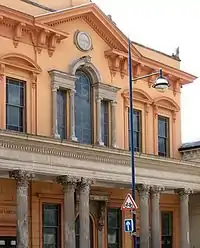 |
II* | 1819 | Two storeyed chapel of brick with stuccoed façade and slate roof. Built in 1819 with substantial additions in 1859 and 1887[32] |
| Barn and stables at Bemersley Farm grid reference SJ 8844 5456 53°5′17″N 2°10′26″W |
II | c.1800 | A U shaped set of farm buildings built at the turn of the 18th and 19th centuries of sandstone and brick with ashlar dressings and a tiled roof. Used by Hugh Bourne as premised to print early books connected with Primitive Methodism[33] | |
| Abbey Farmhouse, Birches Head Road grid reference SJ 9023 4922 53°2′25″N 2°8′49″W |
II | c.1800 | Of brick with some stonework reputedly stone from Hulton Abbey, most of the farmhouse dates from the early 19th century but there is evidence of earlier buildings on the site.[34] | |
| 1 Brook Street, Stoke grid reference SJ 8794 4527 53°0′17″N 2°10′52″W |
II | c.1870 | Originally a house but now offices, 1 Brook Street was built of brick and stone in Tudor Gothic style in the mid to late 19th century.[35] | |
| Tunstall Market, Butterfield Place, Tunstall grid reference SJ 8606 5126 53°3′30″N 2°12′34″W |
II | 1856 | Built in 1856 to the design of G. T. Robinson, the market is in the Neoclassical style of brick interspersed with Staffordshire blue brick bands and stone dressing. The entrance is of ashlar.[36] | |
| The Red House, Chadwick Street, Longton grid reference SJ 9122 4325 52°59′13″N 2°7′55″W |
II | c.1840 | A brick structure, built as a house then subsequently used as a store for items from the decorating kiln at Gladstone pottery works.[37] | |
| Enson Pottery Works, Chelson Street, Longton grid reference SJ 9147 4303 52°59′5″N 2°7′43″W |
 |
II | c.1890 | Late 19th century pottery works with 4 bottle kilns inside the range of buildings.[38] |
| St Bartholomew's Church, Blurton grid reference SJ 8988 4189 52°58′27″N 2°9′7″W |
 |
II | 1626 | Incorporating early 16th century remains, most of St Bartholomew's dates from 1626. Built of sandstone there are later additions of a chancel in 1750, a bellcote designed by George Gilbert Scott in 1846 and a north aisle by Charles Lynham in 1867.[39] |
| Black Boy Inn, Cobridge grid reference SJ 8758 4845 53°2′0″N 2°11′12″W |
II | c.1750 | A former inn, now a house dating from the mid 18th century. Of brick with lined stucco overlay[40] | |
| 266 & 270 Endon Road, Norton grid reference SJ 9027 5235 53°4′6″N 2°8′48″W |
II | c.1798 | The former parish workhouse was converted into two cottages in 1839. A two-storey building of coursed rubble.[41] | |
| St Saviour's Church, Smallthorne grid reference SJ 8839 5040 53°3′3″N 2°10′29″W |
 |
II | c.1840 | A mid 19th century parish church built of random rubble with ashlar facings[42] |
| Three bottle ovens in premises occupied by Bayer United Kingdom Ltd grid reference SJ 8919 4476 53°0′0″N 2°9′45″W |
II | c.1900 | Three calcining ovens; two square based and one conical in shape. All built of brick with iron banding[43] | |
| Elm Tree Cottage grid reference SJ 8679 4485 53°0′3″N 2°11′54″W |
II | 1694 | Two storey, two bayed cottage dating from 1694 in red and blue brick and extensively modified in the 18th and 19th centuries[44] | |
| Chest tomb to John Fenton in St Peter's churchyard grid reference SJ 8794 4512 53°0′12″N 2°10′52″W |
II | 1694 | Tomb of John Fenton, stone chest restored in 1888[45] | |
| Church of St Bartholomew, Norton in the Moors grid reference SJ 8940 5148 53°3′38″N 2°9′34″W |
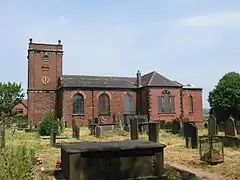 |
II | 1738 | Brick and dressed stone parish church built in 1738 by Richard Trubshaw. Chancel remodelled and North and South chapels added by John Herbert Beckett between 1914 and 1916.[46] |
| The Views grid reference SJ 8700 4486 53°0′53″N 2°11′42″W |
II | early 19th century | The birthplace of Oliver Lodge, The Views are a pair of two storeyed painted brick houses[47] | |
| Regent Theatre grid reference SJ 8825 4748 53°1′28″N 2°10′36″W |
 |
II* | 1929 | Art Deco style building built by W E Trent as a cinema for Provincial Cinematograph Theatres Limited. Steel framed with brick and glazed terracotta (faience) cladding. Renamed the Gaumont in 1950 and the Odeon in 1976, the cinema closed in 1989 but was refitted and reopened as a theatre in 1999.[48] |
| 225, Prince's Road, Hartshill grid reference SJ 8692 4543 53°0′22″N 2°11′47″W |
II | c.1810 | Yellow brick lodge with Doric columned portico[49] | |
| 36, 38 & 40 Queen Street, Burslem grid reference SJ 8678 4973 53°2′41″N 2°11′55″W |
II | 1868 | Row of three shops, of brick and stone construction with slate roof[50] | |
| Wedgwood Institute grid reference SJ 8687 4975 53°2′41″N 2°11′50″W |
 |
II* | 1869 | Two storeyed, redbrick with terracotta panelling and friezes. Used as a library and art school, now empty. Named by The Victorian Society as one of the 2010 top ten most at-risk Victorian buildings in England and Wales.[51][52] |
| Hartshill cemetery chapels grid reference SJ 8643 4538 53°0′20″N 2°12′13″W |
II | c.1850 | Brick Neo-Romanesque style chapels in the Hartshill cemetery. Designed by Charles Lynam in the mid nineteenth century[53] | |
| Cliff Vale Pottery and kilns grid reference SJ 8723 4644 53°0′54″N 2°11′30″W |
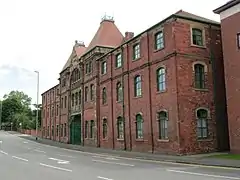 |
II | 1887 | Pottery works of brick with stone dressing. The two surviving kilns have joined bases but separate chimneys[54] |
| Duke of Bridgewater Inn grid reference SJ 8576 4960 53°2′37″N 2°12′50″W |
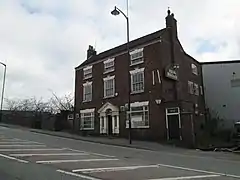 |
II | early 19th century | A three storeyed brick inn, originally used as a dwelling house by the master potter of Bottom Bridge pottery but has been in continuous use as a public house since the 1850s. The inn is named after Francis Egerton, 3rd Duke of Bridgewater, one of the originators of the nearby Trent & Mersey canal.[55] |
| Cemetery Lodge, Shelton grid reference SJ 8773 4632 53°0′51″N 2°11′3″W |
II | c.1860 | Yellow brick lodge at the entrance to Shelton cemetery[56] | |
| Sunnyside Cottage grid reference SJ 8701 4077 52°57′51″N 2°11′41″W |
II | early 17th century | Two cottages, formerly part of the estate of the Dukes of Sutherland. The timber framed buildings have brick infill and tile roofs. One cottage has a number of outbuildings including a bakehouse still with its chimney stack.[57] | |
| Aynsley China Works, Longton grid reference SJ 9137 4340 52°59′16″N 2°7′21″W |
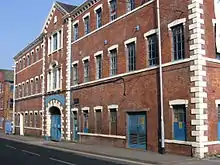 |
II | 1879 | The northern range of buildings belonging to Aynsley China the building encompasses a wide range of architectural styles in a long frontage. One gatehouse is dated 1879 but the entire range was built over a longer period in the second half of the 19th century[58] |
| Tunstall library grid reference SJ 8610 5130 53°3′32″N 2°12′32″W |
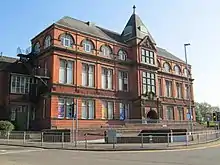 |
II | 1889 | Built as the Victoria Institute, the public library and adjoining public baths were built of red brick with terracotta dressings. The library is of 3 storeys and the baths 2 storeys joined by a common courtyard[59] |
| 3 & 4, The Villas grid reference SJ 8724 4441 52°59′49″N 2°11′30″W |
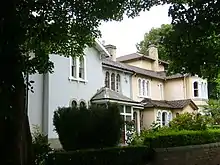 |
II | 1851 | The Villas is an estate of 24 houses designed by Charles Lynam. Numbers 3 & 4 are a pair of semi-detached houses of brick overlaid with stucco and are designed in the Italianate style with concrete tiled roofs[60] |
| 15, The Villas grid reference SJ 8715 4453 52°59′52″N 2°11′35″W |
II | 1851 | The Villas is an estate of 24 houses designed by Charles Lynam. Number 15 is a detached house of brick overlaid with stucco and are designed in the Italianate style with a slate tiled roof. One of the former occupiers was Arnold Machin, the artist and designer.[61] | |
| 18, The Villas grid reference SJ 8720 4450 52°59′52″N 2°11′32″W |
II | 1851 | The Villas is an estate of 24 houses designed by Charles Lynam. Number 18 is a detached house of brick overlaid with stucco and are designed in the Italianate style with a slate tiled roof.[62] | |
| Tontine shops grid reference SJ 8840 4758 53°1′31″N 2°10′28″W |
II | 1837 | A former butcher market now a shopping centre. A single storey rectangular building in ashlar with 5 bayed façade. Built in Greek revival style, it was remodelled in the 1990s after the market closed.[63] | |
| Tunstall clock tower grid reference SJ 8593 5125 53°3′30″N 2°12′41″W |
 |
II | 1893 | A yellow terracotta tower built to commemorate Vice-Admiral Smith Child. Square in section, one side contains the door to the clock room and the other three carry panels showing the names of those who donated to the building of the memorial.[64] |
| Hanley Telephone Exchange grid reference SJ 8809 4758 53°1′31″N 2°10′45″W |
II | c.1900 | The offices and exchange of the National Telephone Company, a 3-storey building in red brick and terracotta. Above the main door is the name "Telephone Buildings" in terracotta.[65] | |
| Gladstone Pottery Museum grid reference SJ 9130 4326 52°59′12″N 2°7′52″W |
Jul2004.jpg.webp) |
II* | c.1860 | Now a museum, the former Gladstone pottery works date mostly from 1860 but there are elements that date back to the start of the 19th century and earlier. The main building range is a long 3 storey building and behind it are a number of kilns and other building ranges arranged around a central courtyard.[66] |
| 184 & 186 Waterloo Road grid reference SJ 8724 4920 53°2′24″N 2°11′30″W |
II | c.1850 | A pair of brick houses with scallop tiled roofs and stuccoed porches.[67] | |
| Queen's Theatre grid reference SJ 8690 4994 53°2′48″N 2°11′48″W |
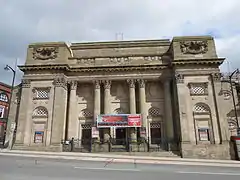 |
II | 1911 | Burslem's third Town Hall designed by the firm of Russell & Cooper is built in ashlar. The front has a full height portico with Corinthian columns. Very soon after completion it became an entertainment venue, Queen's Hall, and in 1966 it became known as the Queen's Theatre.[68] |
| Wade Heath Pottery Works grid reference SJ 8862 4491 53°2′47″N 2°12′4″W |
II | 1814 | Early 19th century pottery works comprising two ranges at right angles to each other with angled corner that formed the original entrance. Ornate pediment and Palladian windows to entrance building.[69] | |
| Statue of Josiah Wedgwood, Winton Square grid reference SJ 9798 4567 53°0′30″N 2°10′50″W |
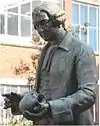 |
II | 1862 | Bronze statue by Edward Davies of Josiah Wedgwood holding a copy of the Portland Vase.[70] |
| Longton Cemetery chapels grid reference SJ 9084 4282 52°58′58″N 2°8′17″W |
II | 1868 | Two timber framed, slate roofed chapels. Each of three bays with tower above[71] | |
| Former Registrar's office, Longton Cemetery grid reference SJ 9082 4290 52°59′0″N 2°8′17″W |
II | 1869 | Two storey office building of wood framing with brick infill and tiled roof. Coat of arms of Longton carried above the porch[72] | |
| Falcon Works grid reference SJ 8738 4494 53°0′6″N 2°11′22″W |
II | 1902–1905 | Early 20th century extension to 1858 works. Comprises two brick built ranges (one single storeyed, one three storeyed) incorporating two kilns in the single storey range. The three storeyed building has a stone plaque of a falcon set in the gable.[73] | |
| 1 & 2, The Villas grid reference SJ 8728 4440 52°59′48″N 2°11′47″W |
II | 1851–1855 | A pair of stucco over brick houses. Concrete tiled roofs, designed by Charles Lynam as part of The Villas Stokeville[74] | |
| 17 & 17A, The Villas grid reference SJ 8719 4451 52°59′52″N 2°11′33″W |
II | 1851–1855 | A pair of stucco over brick houses. Concrete tiled roofs, designed by Charles Lynam as part of The Villas Stokeville[75] | |
| Church of St John the Evangelist, Hanley grid reference SJ 8836 4787 53°1′41″N 2°10′30″W |
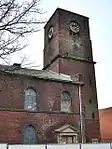 |
II* | 1788–1790 | Now disused church, originally built late 18th century with 19th century additions. Of brick construction with stones dressings and a slate roof. Includes cast iron components in its construction including the window frames, caastellations and gallery columns. This use of cast iron is the second earliest known in the country (the only known earlier examples are in the Church of St James, Liverpool).[76] |
| Harecastle Tunnels, northern portals grid reference SJ 8490 5177 53°3′47″N 2°13′36″W |
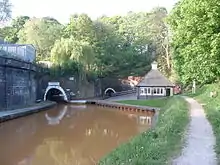 |
II | 1766 | The northern portals of Harecastle Tunnels on the Trent and Mersey Canal were built 60 years apart by James Brindley (1766–1777) and Thomas Telford (1824–1827). Brindley's tunnel mouth is of brick and Telford's is of stone, both set in a brick retaining wall[77] |
| Trent and Mersey Canal lodge, Harecastle grid reference SJ 8490 5177 53°3′47″N 2°13′37″W |
II | 1827 | The canal lodge at the northern end of Harecastle tunnel. A whitewashed brick building of two storeys and a slate roof[78] | |
| Church of the Holy Evangelists, Normacot grid reference SJ 9201 4239 52°58′44″N 2°7′14″W |
 |
II | 1847 | Normacot parish church. Built to the order of the 2nd Duke of Sutherland by George Gilbert Scott and later extended with the addition of a north aisle by John Lewis in the 1890s. Construction is of stone with a tiled roof.[79] |
| Church of St James, Longton grid reference SJ 9144 4313 52°59′7″N 2°7′44″W |
 |
II | 1834 | A Commissioners' church designed by James Trubshaw. Built of ashlar sandstone, later interior modifications added new windows and an organ chamber.[80] |
| Royal Doulton, St Mary's Pottery grid reference SJ 9174 4295 52°59′2″N 2°7′28″W |
II | 1862 | The two storey range at the north west end of the St Mary's pottery was built in 1862 of brick and terracotta. Originally the works of Samuel Moore, they later became the works of Thomas C Wild & Co and later Royal Doulton. Formed of 13 bays a further range of 8 bays was added in 1888.[81] | |
| Our Lady of the Angels and St Peter in Chains Church, Stoke grid reference SJ8738345664 53.0081°N 2.1895°W |
 |
II | 1857 | Gothic Revival Roman Catholic church designed by Charles Hansom and built in 1857.[82] |
| St John's Church, Goldenhill grid reference SJ 8543 5309 53°4′30″N 2°13′8″W |
 |
II | 1840 | Parish church built 1840–41. Designed by Stanley of Shelton. A brick building, in Romanesque style.[83] |
| Library building, London Road, Stoke grid reference SJ 8754 4500 53°0′8″N 2°11′13″W |
 |
II | 1878 | Library and Shakespeare Institute, built in 1878, designed by Charles Lynam. Brick with stone dressing; there are tiled panels, and a mosaic depicting Shakespeare in a central panel.[84] |
| St John's Church, Burslem grid reference SJ 8694 4950 53°2′33″N 2°11′47″W |
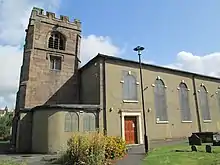 |
II | 1717 | The tower is 16th-century. The rest of the church was rebuilt in 1717; the chancel, with apsidal east end and Palladian window, was added in 1788.[85] |
| Christ Church, Cobridge grid reference SJ 8756 4870 53°2′8″N 2°11′13″W |
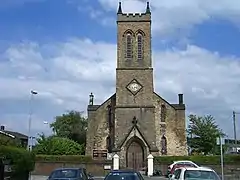 |
II | 1839 | Parish church built 1839–40, enlarged 1845. Designed by Francis Bedford.[86] |
| Christ Church, Fenton grid reference SJ 8910 4450 52°59′52″N 2°9′50″W |
 |
II | 1890 | The parish church, designed by Charles Lynam; built 1890–91, the tower in 1899.[87] |
| Former Fountain Place Works, Burslem grid reference SJ 8670 4978 53°2′43″N 2°11′59″W |
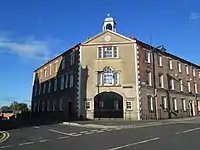 |
II | 1789 | Frontage of former pottery factory, built by Enoch Wood in 1789. The former entrance is in a pedimented bay across the angle between flanking ranges.[88] |
References
- "Listed buildings". English Heritage. Archived from the original on 24 January 2013. Retrieved 27 July 2011.
- Historic England. "Mausoleum, Stone Road (1210451)". National Heritage List for England. Retrieved 4 July 2011.
- Historic England. "Penkhull Farmhouse (1031865)". National Heritage List for England. Retrieved 4 July 2011.
- Historic England. "Vine Public House, Naylor Street (1061402)". National Heritage List for England. Retrieved 4 July 2011.
- Historic England. "Hanley St Lukes Church of England Aided Primary School Infant Building (1119707)". National Heritage List for England. Retrieved 4 July 2011.
- Historic England. "Chest tombs of Whalley and Broade family (1195793)". National Heritage List for England. Retrieved 4 July 2011.
- Historic England. "Cross fragment in St Peter's churchyard (1195794)". National Heritage List for England. Retrieved 4 July 2011.
- Historic England. "Remains of earlier church in St Peter's churchyard (1195795)". National Heritage List for England. Retrieved 4 July 2011.
- Historic England. "North Staffordshire School for the Deaf (1195796)". National Heritage List for England. Retrieved 4 July 2011.
- Historic England. "Elm House (1195797)". National Heritage List for England. Retrieved 4 July 2011.
- Historic England. "Pottery works formerly occupied by Dudosn's Ltd (1195978)". National Heritage List for England. Retrieved 4 July 2011.
- Historic England. "283 Hartsill Road (1195799)". National Heritage List for England. Retrieved 4 July 2011.
- Historic England. "Church of the Holy Trinity (1195800)". National Heritage List for England. Retrieved 4 July 2011.
- Historic England. "Ford Hayes farmhouse (1195801)". National Heritage List for England. Retrieved 4 July 2011.
- Historic England. "Christ Church, High Street (1195802)". National Heritage List for England. Retrieved 4 July 2011.
- Historic England. "Boundary Works (1195803)". National Heritage List for England. Retrieved 4 July 2011.
- Historic England. "Two Bottle Ovens and chimney at Albion Works (1195804)". National Heritage List for England. Retrieved 4 July 2011.
- Historic England. "Longton Centre (1195805)". National Heritage List for England. Retrieved 4 July 2011.
- Historic England. "Former School of Art (1195806)". National Heritage List for England. Retrieved 4 July 2011.
- Historic England. "45, 47 & 49 Longton Road (1195807)". National Heritage List for England. Retrieved 4 July 2011.
- Historic England. "51 & 53 Longton Road, Trentham (1195808)". National Heritage List for England. Retrieved 4 July 2011.
- Historic England. "Church of St Thomas the Apostle (1195809)". National Heritage List for England. Retrieved 4 July 2011.
- Historic England. "36 Market Place (1195810)". National Heritage List for England. Retrieved 4 July 2011.
- Historic England. "Old Town Hall (Burslem Recreation Centre) (1195811)". National Heritage List for England. Retrieved 4 July 2011.
- Historic England. "Former schoolhouse at Stoke Union Workhouse, now occupied by City General Hospital (1195812)". National Heritage List for England. Retrieved 4 July 2011.
- Historic England. "Warehouse in Price and Kensington Works (1195813)". National Heritage List for England. Retrieved 4 July 2011.
- Historic England. "Sutherland Works including two bottle ovens approximately 10 metres south west occupied by Birchcroft China (1195814)". National Heritage List for England. Retrieved 4 July 2011.
- Historic England. "Etruria Hall (1195817)". National Heritage List for England. Retrieved 4 July 2011.
- Historic England. "Etruscan Bone Mill (1195818)". National Heritage List for England. Retrieved 4 July 2011.
- Historic England. "War Memorial in centre of square (1195819)". National Heritage List for England. Retrieved 4 July 2011.
- Historic England. "War Memorial outside municipal offices (1195820)". National Heritage List for England. Retrieved 4 July 2011.
- Historic England. "Bethesda Methodist Chapel (1195821)". National Heritage List for England. Retrieved 4 July 2011.
- Historic England. "Barn and stable ranges at Bemersley Farm (1195822)". National Heritage List for England. Retrieved 4 July 2011.
- Historic England. "Abbey Farmhouse, Birches Head Road (1195823)". National Heritage List for England. Retrieved 4 July 2011.
- Historic England. "1 Brook Street (1195824)". National Heritage List for England. Retrieved 4 July 2011.
- Historic England. "Tunstall Market, Butterfield Place (1195825)". National Heritage List for England. Retrieved 4 July 2011.
- Historic England. "The Red House, Chadwick Street (1195826)". National Heritage List for England. Retrieved 4 July 2011.
- Historic England. "Pottery Works (Enson Works) (1195827)". National Heritage List for England. Retrieved 4 July 2011.
- Historic England. "Church of St Bartholomew (1195828)". National Heritage List for England. Retrieved 4 July 2011.
- Historic England. "Black Boy Inn, Cobridge (1195829)". National Heritage List for England. Retrieved 4 July 2011.
- Historic England. "268 & 270 Endon Road, Norton (1195830)". National Heritage List for England. Retrieved 4 July 2011.
- Historic England. "Church of St Saviour (1195831)". National Heritage List for England. Retrieved 22 December 2011.
- Historic England. "Three bottle ovens in premises occupied by Bayer United Kingdom Ltd (1195832)". National Heritage List for England. Retrieved 22 December 2011.
- Historic England. "Elm Tree Cottage (1195833)". National Heritage List for England. Retrieved 22 December 2011.
- Historic England. "Tomb of John Fenton, St Peter's Churchyard (1195834)". National Heritage List for England. Retrieved 22 December 2011.
- Historic England. "Church of St Bartholomew (1195835)". National Heritage List for England. Retrieved 22 December 2011.
- Historic England. "The Views (1195836)". National Heritage List for England. Retrieved 22 December 2011.
- Historic England. "Odeon Cinema (1198537)". National Heritage List for England. Retrieved 22 December 2011.
- Historic England. "225, Prince's Road (1195838)". National Heritage List for England. Retrieved 23 December 2011.
- Historic England. "36, 38 & 40 Queen Street, Burslem (1195839)". National Heritage List for England. Retrieved 23 December 2011.
- Historic England. "Former Wedgwood Institute (Public Library) (1195840)". National Heritage List for England. Retrieved 4 July 2011.
- "We expose the ten most endangered Victorian buildings". The Victorian Society. 11 October 2010. Archived from the original on 10 November 2011. Retrieved 23 December 2011.
- Historic England. "Hartshill cemetery chapels (1195841)". National Heritage List for England. Retrieved 29 December 2011.
- Historic England. "Former Cliff Vale pottery and calcining kilns now Caradon Twyfords Limited (1195842)". National Heritage List for England. Retrieved 29 December 2011.
- Historic England. "Duke of Bridgewater Inn (1195843)". National Heritage List for England. Retrieved 29 December 2011.
- Historic England. "cemetery Lodge (South) (1195844)". National Heritage List for England. Retrieved 29 December 2011.
- Historic England. "Sunnyside cottage and attached outbuilding and lean to West View (1195845)". National Heritage List for England. Retrieved 29 December 2011.
- Historic England. "Aynsley China Works (Northern range) (1195846)". National Heritage List for England. Retrieved 29 December 2011.
- Historic England. "Tunstall Public Library and Public Baths (1195847)". National Heritage List for England. Retrieved 30 December 2011.
- Historic England. "3 and 4, The Villas (1195848)". National Heritage List for England. Retrieved 30 December 2011.
- Historic England. "15, The Villas (1195849)". National Heritage List for England. Retrieved 30 December 2011.
- Historic England. "18, The Villas (1195850)". National Heritage List for England. Retrieved 30 December 2011.
- Historic England. "The Tontine Shops (1195851)". National Heritage List for England. Retrieved 31 December 2011.
- Historic England. "Clock Tower and attached railings (1195852)". National Heritage List for England. Retrieved 31 December 2011.
- Historic England. "Telephone Buildings (1195853)". National Heritage List for England. Retrieved 31 December 2011.
- Historic England. "Former Gladstone and Park Place (Roslyn) works (1195854)". National Heritage List for England. Retrieved 31 December 2011.
- Historic England. "184 and 186, Waterloo Road (1195855)". National Heritage List for England. Retrieved 3 January 2012.
- Historic England. "Town Hall and Theatre (1195877)". National Heritage List for England. Retrieved 12 August 2012.
- Historic England. "Wade Heath pottery works (1195878)". National Heritage List for England. Retrieved 12 August 2012.
- Historic England. "Statue of Josiah Wedgwood in centre of square (1195879)". National Heritage List for England. Retrieved 12 August 2012.
- Historic England. "Longton Cemetery Chapels (1210413)". National Heritage List for England. Retrieved 12 August 2012.
- Historic England. "Former Registrar's office at Longton cemetery (1210415)". National Heritage List for England. Retrieved 12 August 2012.
- Historic England. "Falcon Works pot bank occupied by Portmerion Potteries Limited (1210472)". National Heritage List for England. Retrieved 12 August 2012.
- Historic England. "1 & 2, The Villas (1210534)". National Heritage List for England. Retrieved 12 August 2012.
- Historic England. "17 & 17A, The Villas (1210555)". National Heritage List for England. Retrieved 12 August 2012.
- Historic England. "Church of St John the Evangelist (1210680)". National Heritage List for England. Retrieved 12 August 2012.
- Historic England. "Trent and Mersey canal Harecastle tunnel portals and attached retaining walls (1210692)". National Heritage List for England. Retrieved 4 July 2011.
- Historic England. "Trent and Mersey Canal lodge, Harecastle (1210701)". National Heritage List for England. Retrieved 11 May 2013.
- Historic England. "Church of the Holy Evangelists (1210710)". National Heritage List for England. Retrieved 11 May 2013.
- Historic England. "Church of St James, Longton (1210730)". National Heritage List for England. Retrieved 11 May 2013.
- Historic England. "St Mary's Pottery (1210805)". National Heritage List for England. Retrieved 11 May 2013.
- Church of Our Lady and St Peter in Chains from British Listed Buildings, retrieved 2 January 2015
- Historic England. "Parish Church of St John the Elder (1220492)". National Heritage List for England. Retrieved 29 October 2018.
- Historic England. "Library (1220603)". National Heritage List for England. Retrieved 26 October 2018.
- Historic England. "Church of St John the Baptist (1291065)". National Heritage List for England. Retrieved 22 July 2019.
- Historic England. "Christ Church (1291092)". National Heritage List for England. Retrieved 28 October 2018.
- Historic England. "Christ Church (1297931)". National Heritage List for England. Retrieved 25 October 2018.
- Historic England. "Former Fountain Place Works (1297935)". National Heritage List for England. Retrieved 25 October 2018.